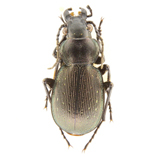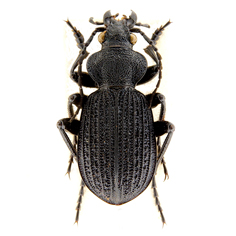Subgenus Carabops Jakobson, 1900
Carabops Jakobson, 1900: 261 (Typus kachovskyi Jakobson, 1900 = abyssinicus Gestro, 1880)
Mimotefflus Vuillet, 1910: 103 (Typus oberthueri Vuillet, 1910)
Carabosophrus Lapouge, 1931: 398 (Typus burtoni Alluaud, 1913)
According to Jeannel (1940: 64), the African wingless Calosoma, linked to the mountain habitat of ground and grassland, belong to genera (treated as subgenera in this study): Carabops, Orinodromus and Carabomorphus, and their origin can be traced back to the Castrida - Caminara phyletic line.
The lack of serration on the margin of the elytra that characterizes most of the not flying Calosoma can be used to differentiate these subgenera from the other ones belonging to the same phyletic line.
Among the subgenera of African fligthless Calosoma, the Carabops subgenus sems to be the less evoluted one, as it still has strigose mandibles, and punctate metaepisternum and the inner armature of the penis has a normally formed ligule, short and triangular.
Carabops, when living in montainous areas, between 1800 and 2200 up to 3200m, adapt to different environments such as alpine grassland, margins of cultivated fields, and wooded areas, while, when they are living at medium altitude under 1800/1500 down to 500m, seem to be strictly forestal.
A group of species are endemic to Ethiopia, and occupy the northern plateau and the hills and the bottom of the Rift Valley. Another group of species are found in the medium altitude forestal areas of northern Tanzania, in the alpine grassland and in the forest around Lake Malawi, in the highlands of Katanga and in the plateau of Angola. In this last two cases the solution of continuity could be only apparent, as it regards two strictly related populations, possibly pertaining to a single species that from the highlands of Katanga reappears in the Bihé plateau in Angola and the resulting gap could be caused by the scarcity of entomological researches in the area.
The disjunct distribution pattern noted by Brühl (1977: 239), would therefore to be reconsidered and the current distribution would seem consistent with the hypothesis of a continous montane forest belt from East to West in former times. However, this hypothesis is not currently universally accepted and the problem of origin and distribution of the Carabops subgenus remains open.
The model of the sculpture of the elytron in all species has 15 intervals ("triploïde" type of Jeannel) and evolves in both groups from a sculpture regular with intervals of the same width and height (sculpture "homodyname" of Jeannel) towards types, in which some intervals dissolve in granules or surface roughness while other intervals are more raised (sculpture "hétérodyname" of Jeannel). In parallel, in the species with these more advanced forms of sculpture, the general shape of the body tends to become more slender with pronotum less transverse and elytra more elongated.
Every species of this subgenus is brachypterous (the wings are reduced to a more or less short stump).


